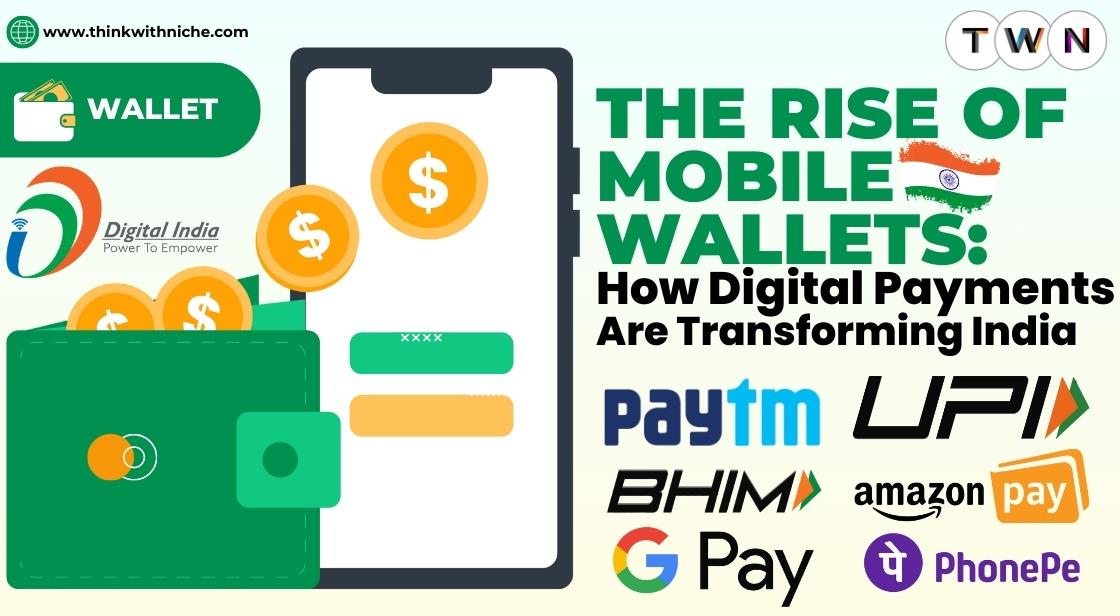The Rise of Mobile Wallets: How Digital Payments Are Transforming India

Blog Post
India is undergoing a digital revolution, with mobile wallets at the forefront of this transformation. The nation is rapidly shifting from a predominantly cash-based economy to one driven by digital payments.
This shift is being propelled by a confluence of factors, including technological advancements, government initiatives, and changing consumer behavior.
The advent of smartphones, coupled with increasing internet penetration, has created a fertile ground for the growth of mobile wallets. These digital payment platforms offer convenience, security, and accessibility, making them an attractive alternative to traditional payment methods.
Moreover, government initiatives such as demonetization and the Digital India mission have accelerated the adoption of digital payments by creating a conducive environment for mobile wallet proliferation.
This article delves deeper into the factors driving the surge in mobile wallet usage, its impact on the Indian economy, and the challenges and opportunities that lie ahead. It examines how mobile wallets have evolved from basic payment instruments to multifunctional platforms, catering to a wide range of user needs.
Additionally, it explores the role of government policies, technological advancements, and changing consumer behavior in shaping the future of mobile payments in India.
By understanding the key drivers and trends shaping the mobile wallet landscape, we can gain valuable insights into the potential of this transformative technology to reshape India's financial ecosystem.
The Rise of Mobile Wallets: How Digital Payments Are Transforming India?
In recent years, India has undergone a dramatic shift in how financial transactions are conducted, moving away from cash towards digital payment methods. The surge in mobile wallet payments is at the forefront of this transformation, reflecting the broader evolution of fintech in the country.
As India's population becomes increasingly tech-savvy, particularly among the younger generation, mobile wallets are becoming a cornerstone of the nation’s digital economy. This article delves into the factors behind this rise, the challenges it faces, and the future prospects of mobile wallet payments in India.
Fintech Evolution in India
Fintech in India has evolved rapidly, fundamentally changing the way financial services operate by leveraging advanced technologies. This transformation has been driven by the country's youthful population, which has eagerly adopted digital payments. While cash still holds significance, a growing number of Indians are opting for digital transactions due to their convenience and security.
The introduction of platforms like Unified Payments Interface (UPI), mobile wallets, and mobile banking has made digital payments seamless and accessible. UPI, launched in 2016, allows instant money transfers between bank accounts and has quickly gained popularity due to its ease of use and innovative features. As of February 2024, UPI has expanded its reach to countries like Sri Lanka, Mauritius, and the UAE, with plans to extend to Singapore and France in the near future.
The Surge in Digital Transactions in India
India has been at the forefront of a digital payments revolution, driven by technological advancements, government initiatives, and a rapidly growing digital ecosystem. The country has witnessed a remarkable surge in digital transactions, transforming the way financial transactions are conducted.
A Historic Rise in Digital Payments
The adoption of digital transactions in India has seen an unprecedented rise, especially over the past decade. According to data from the Press Information Bureau (PIB), the volume of digital payments skyrocketed from 2,071 crore transactions in 2018 to a staggering 13,462 crore transactions in 2023.
This exponential growth is a testament to the country's shift towards a cashless economy, fueled by the increasing penetration of smartphones, internet access, and a robust digital payments infrastructure.
The Growing Value of Digital Transactions
Not only has the volume of digital transactions increased, but the value of these transactions has also seen significant growth.
The total value of digital transactions reached a whopping US$ 40.1 trillion (Rs. 3,344 lakh crore) in 2023, reflecting a compound annual growth rate (CAGR) of 11.2% over the five-year period.
This surge in value indicates a strong consumer and business trust in digital payment methods, further solidifying their position as the future of financial transactions in India.
Also Read: The Evolution of Digital Personas from Chatbots to Digital Avatars
Key Drivers of Digital Payment Adoption
Several factors have contributed to the rapid adoption of digital payments in India. These include:
-
Unified Payments Interface (UPI): Launched in 2016, UPI has revolutionized digital payments by enabling seamless, instant money transfers between bank accounts. Its user-friendly interface and wide acceptance have made it the most popular digital payment method in India. As of early 2024, UPI has processed over 10 billion transactions per month, demonstrating its widespread adoption.
-
Government Initiatives: The Indian government's push for a cashless economy, particularly after the 2016 demonetization, has played a significant role in driving digital payment adoption. Initiatives like Digital India and the promotion of UPI-based apps like BHIM have made digital payments more accessible to the masses.
-
E-commerce Growth: The booming e-commerce sector in India has also fueled the growth of digital payments. With online shopping becoming increasingly popular, consumers are opting for digital payment methods for their convenience and security.
-
COVID-19 Pandemic: The COVID-19 pandemic accelerated the shift towards digital payments, as people avoided physical contact and opted for contactless payment methods. The pandemic highlighted the importance of digital transactions, further boosting their adoption.
A Diverse Array of Digital Payment Methods
Digital transactions in India encompass a wide range of methods, each catering to different user preferences and needs. These include:
-
Credit/Debit Cards: Despite the rise of mobile payments, credit and debit cards remain a popular choice for digital transactions. With enhanced security features like EMV chips and contactless payment options, cards continue to be a trusted payment method.
-
Mobile Wallets: Mobile wallets, such as Paytm, Amazon Pay, and Google Pay, have gained immense popularity due to their ease of use and integration with other services. These wallets allow users to store money digitally and make payments with a simple tap on their smartphones.
-
Internet Banking: Internet banking remains a crucial component of digital payments, offering users the ability to transfer funds, pay bills, and manage their finances online. With enhanced security measures and user-friendly interfaces, internet banking continues to be a reliable option for digital transactions.
-
Payment Apps: Payment apps like BHIM, PhonePe, and Google Pay have become household names in India. These apps leverage UPI to enable quick and secure transactions, making them a preferred choice for many users.
-
Point of Sale (PoS) Terminals: PoS terminals have evolved beyond traditional card swiping machines. Modern PoS systems now support QR code payments, UPI, and mobile wallet transactions, making them versatile tools for merchants.
Recent Developments and Innovations in Digital Payments
The digital payment landscape in India continues to evolve, with new developments and innovations emerging regularly. Some of the latest trends include:
UPI Lite:
Introduced in 2022, UPI Lite is a simplified version of UPI designed for small transactions under Rs. 500 (US$ 5.99). This feature has been particularly popular among rural users and small merchants, providing a quick and easy way to make low-value payments without needing an active internet connection.
Cross-Border UPI Transactions:
In a bid to expand UPI's global footprint, India has initiated partnerships with several countries, including Singapore, the UAE, and France, to enable cross-border UPI transactions. This development is expected to further increase UPI's usage among Indian expatriates and international businesses.
Digital Rupee (e₹):
The Reserve Bank of India (RBI) has introduced the Digital Rupee, a central bank digital currency (CBDC) that offers a new form of digital payment. The e₹ aims to complement existing digital payment methods, offering users a government-backed alternative that combines the benefits of physical cash with the convenience of digital transactions.
Enhanced Cybersecurity Measures:
As digital payments grow, so do concerns about cybersecurity. To address these concerns, the government and financial institutions are implementing advanced security measures, such as two-factor authentication, biometric verification, and AI-based fraud detection, to protect users from cyber threats.
The Future of Digital Transactions in India
The future of digital transactions in India looks promising, with continued growth expected in the coming years. The government's focus on financial inclusion, the rise of fintech startups, and the increasing adoption of digital payment methods by businesses and consumers alike are all contributing to this positive outlook.
By 2027, digital payments in India are expected to reach a value of US$ 100 trillion, driven by innovations in payment technology, increased smartphone penetration, and a young, tech-savvy population. As India moves closer to becoming a cashless society, digital transactions will play an increasingly vital role in shaping the country's economic landscape.
In conclusion, the surge in digital transactions in India represents a significant shift towards a more efficient, secure, and inclusive financial system. As digital payment methods continue to evolve and expand, they will undoubtedly become an integral part of everyday life for millions of Indians, paving the way for a digitally empowered economy.
The Evolution of Mobile Wallets
Mobile wallets, also known as e-wallets, have emerged as one of the most significant modes of digital transactions. Similar to traditional wallets, mobile wallets allow users to store money digitally for purchases, making transactions safer and more convenient by eliminating the need to carry cash or credit cards. These wallets are typically accessed through mobile apps and function as a prepaid payment method, enabling users to store funds for future use.
Although prepaid payment instruments (PPIs) have been available in India since 2002, their early usage was limited to specific purposes like gift cards and meal reimbursements. The introduction of digital wallets, however, has significantly accelerated the adoption of PPIs, transforming them into a mainstream method of payment.
The Explosive Growth of Mobile Wallet Payments
Mobile wallet payments in India have experienced explosive growth, increasing at a CAGR of 72.1% to US$ 2.5 trillion (Rs. 202.8 lakh crore) between 2019 and 2023, according to data from Business Standard. This rapid growth can be attributed to several factors:
Government Initiatives
The Indian government's consistent efforts to promote digital payments have played a crucial role in the widespread adoption of mobile wallets. Initiatives such as demonetization in 2016 and the Digital India mission have encouraged people to transition to electronic payments, fostering a cashless economy.
RBI Regulations
The Reserve Bank of India (RBI) has also been instrumental in regulating and promoting the use of mobile wallets. In March 2022, the RBI mandated that all prepaid payment instruments, including wallets, be compliant with UPI. Furthermore, in April 2024, the RBI allowed mobile wallet users to spend their balance on third-party UPI apps, adding another layer of convenience for users and boosting mobile wallet adoption.
Factors Driving the Surge in Mobile Payments
Increased Smartphone Usage
The rise in smartphone usage is one of the key drivers behind the growth of mobile payments. With over 931 million smartphone users in India as of September 2023, and projections indicating this number will exceed 1.1 billion by 2025, the accessibility and convenience of smartphones have made them a preferred tool for conducting digital transactions.
Contactless Payments and Convenience
Mobile payments offer a highly convenient and hygienic way to conduct transactions, especially in the post-pandemic world. Contactless payment methods, facilitated by mobile wallets, have become increasingly popular as they provide a secure, touch-free way to pay.
Enhanced Security with Biometric Authentication
As mobile transactions increase, so do concerns about security. To address these concerns, biometric authentication methods such as fingerprint scanning and facial recognition have become common features in mobile wallets. These technologies not only enhance security but also simplify the authentication process, further driving the adoption of mobile wallets.
Multifunctionality of Mobile Wallets
Modern mobile wallets like Apple Pay, Google Pay, and Samsung Pay have evolved beyond basic payment functions. They now offer additional features such as loyalty programs, ticketing, and boarding passes, making them indispensable tools for everyday transactions.
The Rise of Mobile Point-of-Sale (mPOS) Systems
Mobile Point-of-Sale (mPOS) systems are gaining traction, particularly among small and medium-sized businesses. These systems allow merchants to accept payments using smartphones or tablets, enhancing the flexibility and convenience of sales transactions.
Gen Z Leading the Mobile Payment Revolution
The younger generation, particularly Gen Z, is driving the mobile payment revolution. Comfortable with technology and quick to adopt new trends, Gen Z is leading the shift towards mobile peer-to-peer (P2P) transfers. According to eMarketer, 80.4% of new users embracing mobile P2P transfers from 2023 to 2027 will belong to this generation, indicating a significant shift in how future generations will manage their finances.
UPI Lite: A Catalyst for Mobile Wallet Adoption
UPI LITE, launched in March 2022, is a wallet payment solution designed for small transactions under Rs. 500 (US$ 5.99). It operates within the existing UPI framework, ensuring consistency and compliance while offering a user-friendly experience for low-value transactions. Many mobile wallet apps, including Paytm, PhonePe, Amazon Pay, and Google Pay, now integrate UPI functionality, allowing users to make payments directly from their wallets.
Key Trends Shaping the Mobile Wallet Landscape:
-
Super Apps: The convergence of various services, including payments, messaging, and entertainment, within a single app.
-
Biometric Authentication: Increasing adoption of fingerprint, facial, and iris recognition for enhanced security.
-
Near-Field Communication (NFC) Technology: Enabling contactless payments and peer-to-peer transactions.
-
Blockchain Integration: Enhancing security and transparency in transactions.
-
Artificial Intelligence (AI): Leveraging AI for fraud detection, personalized recommendations, and customer support.
By staying ahead of technological advancements and adapting to evolving consumer needs, mobile wallet providers can continue to drive innovation and growth in the digital payments ecosystem.
Addressing Challenges in Mobile Wallet Adoption
Cybersecurity Concerns
As mobile wallets become more popular, the risk of cyber-attacks has increased. Hackers and scammers frequently target mobile payment apps, leading to data breaches and financial losses. In response, the government is implementing measures to enhance cybersecurity, such as blocking unique mobile device identifiers (IMEI) and imposing limits on withdrawals from suspicious accounts.
Accessibility Issues in Rural Areas
In many rural parts of India, limited access to reliable internet and electricity hampers the use of digital payment services. To address this, the government has launched initiatives like the 24-hour TV channel 'DigiShala' to educate citizens about digital payments and encourage their adoption.
Low Digital Literacy
A lack of digital literacy, particularly among the older generation and underserved communities, poses a barrier to the widespread adoption of mobile wallets. The government is tackling this issue through programs like the Pradhan Mantri Gramin Digital Saksharta Abhiyan (PMGDISHA), which aims to improve digital literacy across the country.
Government Initiatives Supporting Mobile Wallet Adoption
Demonetization
The 2016 demonetization initiative played a pivotal role in accelerating the adoption of digital payments. With cash in short supply, people turned to electronic transactions, boosting the growth of mobile wallets, mobile banking, and online payment platforms.
Digital India Mission
Launched to transform India into a digitally empowered society, the Digital India mission has been a key driver behind the rise of mobile wallets and UPI-based transactions. By promoting digital infrastructure and connectivity, this initiative has empowered citizens with convenient and secure digital payment options.
BHIM App
The Bharat Interface for Money (BHIM) app, launched by the government, is a mobile payment app based on UPI. It offers a simple and secure way to conduct digital transactions, enabling users to send and receive money using their smartphones.
Financial Inclusion
The government’s focus on financial inclusion has also contributed to the growth of mobile wallets. Programs like the Pradhan Mantri Jan Dhan Yojana (PMJDY) have expanded access to banking services, allowing more people to participate in digital transactions.
The Road Ahead
The transition from cash to digital clicks, driven by the growing popularity of mobile wallet payments, highlights India's revolutionary journey towards a digital economy. With mobile wallets becoming an integral part of daily life, the future of payments in India looks increasingly digital.
According to GlobalData, the value of mobile wallet transactions in India grew at a robust CAGR of 72.1% to reach US$ 2.5 trillion from 2019 to 2023. Looking ahead, mobile wallet payments are expected to continue their rapid growth, with a projected CAGR of 18.3% to exceed US$ 5.5 trillion by 2027.
This growth will be fueled by a combination of technological advancements, supportive government policies, and the increasing adoption of digital payment methods across the country.
Conclusion
The meteoric rise of mobile wallets in India signifies a profound shift in the country's payment landscape. From being a nascent concept to becoming a mainstream mode of transaction, mobile wallets have redefined the way Indians conduct financial activities. The confluence of factors, including government support, technological advancements, and changing consumer behavior, has propelled this transformation.
As India continues its journey towards a cashless society, the role of mobile wallets will only grow in importance. The future holds immense potential for innovation and expansion in this sector. With advancements in areas like artificial intelligence, blockchain, and biometrics, mobile wallets are poised to become even more secure, convenient, and feature-rich.
However, challenges such as cybersecurity and digital literacy persist and require ongoing attention. Addressing these issues will be crucial for ensuring the sustained growth and widespread adoption of mobile wallets. By fostering a robust digital payment ecosystem, India can unlock new opportunities for economic growth, financial inclusion, and digital empowerment.
Ultimately, the success of mobile wallets in India is a testament to the country's ability to embrace technology and innovate to address its developmental challenges. As the digital revolution unfolds, mobile wallets are at the forefront, driving India towards a cashless and inclusive future.
You May Like
EDITOR’S CHOICE












